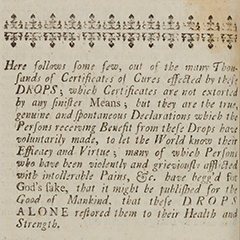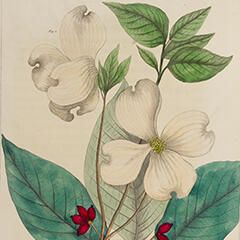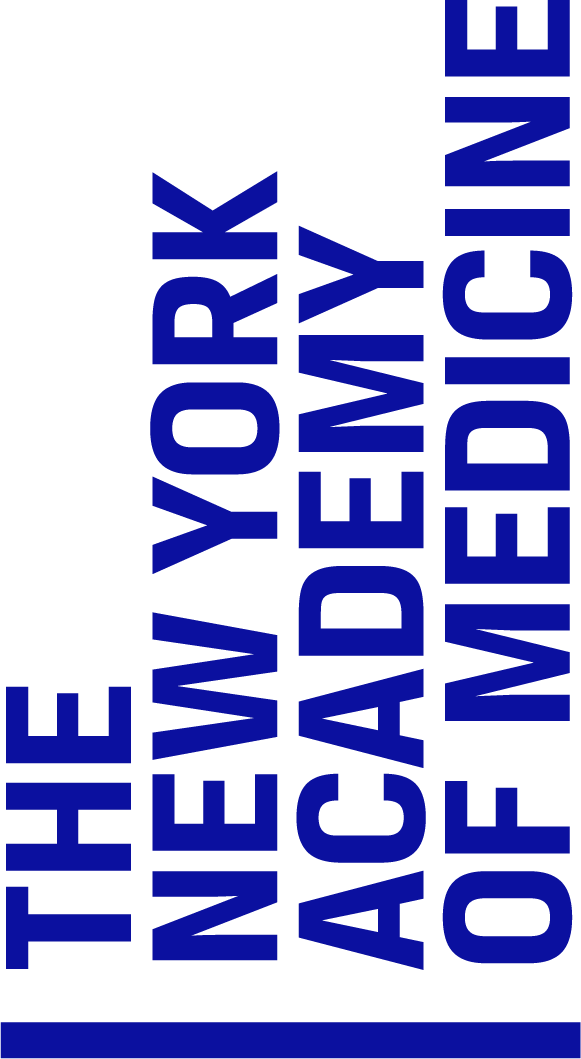Drugs and Medicine
Warning message
You must
authorize Drupal to use your Google Analytics account before you can view reports.
Primary tabs
-

-
An Abstract of the Patent Granted by His Majesty King George…
-
Patent medicines originated in England in the mid 17th century and were marketed with extravagant claims, offering cures for a host of maladies. Recommendations for dosage were vague, and ingredients (often including opium) were usually not specified. In 1726 Benjamin Okell was granted the royal patent for Dr. Bateman’s Pectoral Drops, a tincture of gambir (an astringent extract from an Asian plant) and opium. Advertisements published in the London Mercury as early as 1721 directed prospective customers to the warehouse and printing shop at Bow's Churchyard, where they could purchase the drops for one shilling. Our copy of the 1731 reprint by Peter Zenger is likely the first piece of medical printing in New York. Zenger, who would later
Show morePatent medicines originated in England in the mid 17th century and were marketed with extravagant claims, offering cures for a host of maladies. Recommendations for dosage were vague, and ingredients (often including opium) were usually not specified. In 1726 Benjamin Okell was granted the royal patent for Dr. Bateman’s Pectoral Drops, a tincture of gambir (an astringent extract from an Asian plant) and opium. Advertisements published in the London Mercury as early as 1721 directed prospective customers to the warehouse and printing shop at Bow's Churchyard, where they could purchase the drops for one shilling. Our copy of the 1731 reprint by Peter Zenger is likely the first piece of medical printing in New York. Zenger, who would later become famous for printing seditious texts, was instrumental in establishing freedom of the press in America. The Academy has the only known copy. Bound with our copy of the abstract is a copy of A Short treatise of the virtues of Dr. Bateman's Pectoral Drops, also issued by Okell and his printing house partners. Here, Batemans efficacy as a treatment for numerous ailments are described in sections dedicated to each. The last section of the treatise offers testimonials from satisfied customers. READ MORE→
Show less
-

-
Historia naturalis Brasiliae
-
The Dutch West India Company occupied northeastern Brazil for thirty years, from 1624 to 1654. The first ten years of occupation financially strained the Company, despite considerable profits made from sugar, Brazil-wood, and loot swiped from Iberian ships. In 1636, Johann Maurits arrived to govern, tasked with stabilizing the settlement. Under his leadership (which lasted until 1644), the colony thrived. Among the forty-six artists and scholars Maurits hired as his research staff to promote scientific studies in Brazil were the physician Willem Piso and astronomer Georg Markgraf, who arrived in 1638. The Historia naturalis Brasiliae, their collaborative illustrated folio volume, in twelve books, was published in 1648. Rich in description
Show moreThe Dutch West India Company occupied northeastern Brazil for thirty years, from 1624 to 1654. The first ten years of occupation financially strained the Company, despite considerable profits made from sugar, Brazil-wood, and loot swiped from Iberian ships. In 1636, Johann Maurits arrived to govern, tasked with stabilizing the settlement. Under his leadership (which lasted until 1644), the colony thrived. Among the forty-six artists and scholars Maurits hired as his research staff to promote scientific studies in Brazil were the physician Willem Piso and astronomer Georg Markgraf, who arrived in 1638. The Historia naturalis Brasiliae, their collaborative illustrated folio volume, in twelve books, was published in 1648. Rich in description of native life, the book contains 446 remarkable woodcuts illustrating local flora and fauna, and comprises the most important early documentation of zoology, botany and medicine in Brazil. The woodcuts are based on an original collection of paintings and sketches, now lost; many of these original depictions were likely done by Markgraf himself. The first four books were written by Piso, and deal mainly with diseases native to Brazil and their remedies. Piso, assigned as Maurits’ personal physician, turns his clinical eye to the ways of the native populations, from whom he makes several important discoveries. He offers a vivid account of a patient in the throes of tetanus, and suggests that the root cause of the ailment may be a minor wound, of the kind that craftspeople incur while working. The remaining eight books, subtitled Historia rerum naturalium Brasiliae and mostly devoted to natural history, were written by Georg Markgraf. These sections were devoted to the medical uses of plants; to fish, birds, insects, quadrupeds and reptiles; and to full descriptions of geographic regions and their inhabitants. Images from two of these books, dealing with quadrupeds, and with insects, are pictured here. Markgraf describes the appearance, habits, and environment of each animal depicted. Some of the four-legged creatures pictured have the names we might still use today: the armadillo, on page 231, would be recognizable as such to a child, as would a short-legged jaguar, on page 235. In other cases, it’s more difficult to link the textual description with the images– the placement of the woodcuts doesn’t always correspond with the text. Is, for example, the shaggy llama on page 244 the Peruvian sheep referenced in the header? Markgraf points out that the creature pictured has a two-toed foot on his back legs, just as a llama does. The lushly illustrated and very beautiful frontispiece features a European traveler, presumably Dutch, reclining before two natives in a verdant green wood, teeming with wildlife. Piso, Willem. Historia naturalis Brasiliae. Leiden, 1648. Photography by Ardon Bar-Hama courtesy of George Blumenthal.
Show less
-

-
Specimen Medicinae Sinicae
-
The Specimen Medicinae Sinicae is the first illustrated book published on Chinese medicine in the West. It contains an overview of Chinese medical practices including acupuncture and meridian theories, semiology of the tongue, descriptions of Chinese pharmaceuticals and their uses, and an important translation of a Ming treatise on pulse diagnosis. The Specimen includes thirty engraved plates and woodcut illustrations in the text, depicting the Chinese doctrine of the pulse and the semiology of the tongue, along with eight tables showing the variations of the pulses. Explaining Chinese pulse theory to a European audience proved difficult. Insufficient description of the plates, which pictured figures with doubled lines running through the
Show moreThe Specimen Medicinae Sinicae is the first illustrated book published on Chinese medicine in the West. It contains an overview of Chinese medical practices including acupuncture and meridian theories, semiology of the tongue, descriptions of Chinese pharmaceuticals and their uses, and an important translation of a Ming treatise on pulse diagnosis. The Specimen includes thirty engraved plates and woodcut illustrations in the text, depicting the Chinese doctrine of the pulse and the semiology of the tongue, along with eight tables showing the variations of the pulses. Explaining Chinese pulse theory to a European audience proved difficult. Insufficient description of the plates, which pictured figures with doubled lines running through the bodies, confused western audiences, who interpreted these representations as indication that the Chinese didn't know their anatomy. The publication of the Specimen Medicinae Sinicae did little to change the commonly-held belief that the Chinese were crackerjack diagnosticians, with a misguided idea of the body's interior. The tenets of Chinese medicine and diagnostics were also somewhat muddled in the minds of westerners. Nevertheless, the translation did much to introduce pulse lore, acupuncture, and new materia medica to a Western audience of medical practitioners eager to experiment. READ MORE→
Show less
-

-
Vegetable Materia Medica of the United States: or, Medical Botany
-
The Vegetable Materia Medica, by the botanist William P.C. Barton, was published 1817-1819 in an edition of 500 copies containing fifty hand-colored plates. This offered one of the first illustrated books depicting medicinal plants native to America, allowing for their identification, and facilitating their use. Barton published widely on both botanical and medical topics, as well has having a reputation as an adept surgeon and a fine clinician skilled in the treatment of diseases. Both Barton’s classical background and his extensive knowledge of medicine are on display in this book. The text of Barton’s volumes explain the appearance, the habitat, and the genesis of each plants scientific and vulgar names, as well as their medical
Show moreThe Vegetable Materia Medica, by the botanist William P.C. Barton, was published 1817-1819 in an edition of 500 copies containing fifty hand-colored plates. This offered one of the first illustrated books depicting medicinal plants native to America, allowing for their identification, and facilitating their use. Barton published widely on both botanical and medical topics, as well has having a reputation as an adept surgeon and a fine clinician skilled in the treatment of diseases. Both Barton’s classical background and his extensive knowledge of medicine are on display in this book. The text of Barton’s volumes explain the appearance, the habitat, and the genesis of each plants scientific and vulgar names, as well as their medical properties. The exceptionally-beautiful illustrations were hand-painted by Barton’s wife, Esther. Barton often offered multiple depictions of each plant, the first illustrating the plant as you might come upon it, in situ, and others showing the roots and the parts of the flower or leaves in detail. One plate illustrating purple skunk-cabbage is brilliantly-rendered as described by Barton in the text; Barton enumerates the plant’s virtues as a respiratory aid for asthmatics, as an expectorant, and as a useful antispasmodic. Barton treats each plant described similarly. READ MORE→
Show less




